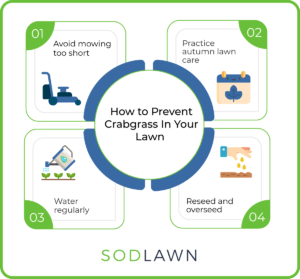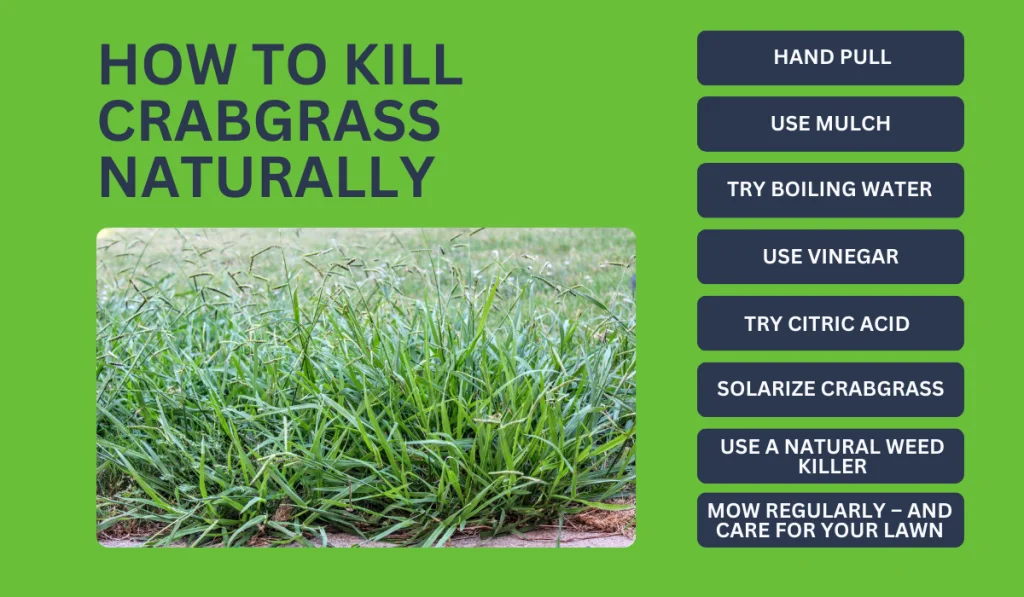Weeds are inevitable in any lawn or garden, but there are good weeds and harmful weeds. “Good weeds” are typically considered plants with some benefits, like clover (which adds nitrogen to the soil).
Then there are the pesky “bad weeds” like crabgrass that just take over and make your lawn look terrible.
So, how do you get rid of crabgrass naturally? Read on for all the information you need to know – including some effective organic solutions – to help you get rid of crabgrass and other frustrating lawn weeds.
Key Takeaways
- Crabgrass is a stubborn annual weed that thrives in dry conditions with high soil temperatures.
- The best defense against crabgrass is to keep your lawn healthy and well-watered.
- You can employ many organic methods throughout the year to kill crabgrass naturally, such as weeding, using mulch, and using vinegar.
What is Crabgrass?
Crabgrass is one of the most tenacious weeds that you’ll find in the garden – to be frank, it’s a gardener’s worst nightmare.
This nuisance plant is frustrating, but the good news is that it’s common, meaning there are plenty of solutions out there that you can employ to help you get rid of it.
Crabgrass is the common name for a fast-growing and fast-spreading plant, Panicum sanguinale. It’s aptly named, too, since its crooked stems and low growth habit look a lot like crab’s legs.
This weed grows in such a way that it makes it difficult for other grass types to grow. It creates unattractive bald spots and crowds out desired grass types, flowering plants, and other crops.
How to Prevent Crabgrass in Your Lawn
The best way to prevent crabgrass plants from taking over? Grow a healthy lawn! Here are some tips to help you prevent crabgrass.
Avoid Mowing Too Short
One of the most common reasons for the spread of crabgrass is when you mow the lawn too short. If you mow too closely (down to half an inch or so), crabgrass will reveal itself as thin, bare patches in the lawn.
Therefore, it is crucial that you only mow to the height required by the specific type of grass you’re growing (usually, around 1-4”).
This is even more important when the weather is hot and dry when crabgrass thrives. This is disadvantageous, too, in that most other types of grass (the ones you’re trying to grow) tend to slow their growth during these hot, dry periods.
Practice Autumn Lawn Care
You’ll likely notice that crabgrass becomes the most prevalent during the late summer months, but one of the most effective ways to get rid of it is to work at eradicating it throughout the entire year.
Even after it seems as though the grass has stopped growing, remember that it will keep growing until the first frost. Therefore, you mustn’t neglect mowing and other maintenance tasks. This will ensure that your grass stays healthy and that crabgrass doesn’t creep in.
Autumn is also a good time to aerate the lawn. You will remove soil plugs and reduce compaction, helping grass roots grow deeper and stronger.
One more step you can take to prevent crabgrass in the fall is to rake it regularly. Fallen leaves can block out the sunlight that your grass needs for food.
Water Regularly
Although crabgrass thrives in dry, hot conditions, most grass types do not. Give your grass the best chance of survival by making sure that your lawn stays nice and moist. Water regularly, ensuring the soil is evenly moist when you give it a good soaking with the garden hose.
Reseed and Overseed

The best way to combat crabgrass? Don’t give it a chance to dig its roots in. Reseed and overseed your lawn often, whenever it starts to look thin. When bare spots appear, repair them with new sod or grass seeds.
Don’t let crabgrass overtake the area, and instead, choke out any crabgrass seeds that may be lingering in the soil with the seeds for the plants you want to grow, like St. Augustine grass, Kentucky bluegrass, or whatever other kind of grass you’re trying to grow.
How to Kill Crabgrass Naturally

For the best results in getting rid of crabgrass and letting your cultivated lawn grasses thrive, follow these tips and give these natural crabgrass killers a try.
Hand Pull
The easiest way to get rid of crabgrass, particularly if you only have a few small patches to contend with, is to pull it by hand.
This is easier said than done since crabgrass spreads with tough, sprawling root systems. Crabgrass can continue to spread if any roots are left in the soil when you weed. Make sure you get as much of the root as you can. Using a weeder tool may help.
Use Mulch
Mulch can also be a helpful natural solution for getting rid of crabgrass. Put down a three-inch-thick layer of mulch (materials like straw, wood chips, landscape fabric, and newspaper are all excellent choices). You can also use black plastic or paver blocks to smother the weeds – just make sure the material doesn’t cover any nearby plants you’d like to keep.
Try Boiling Water
For more isolated patches of crabgrass, you can douse them with boiling water. Saturate the area with water at boiling temperatures. The water will kill any plants it comes into contact with, so be careful about using this method too judiciously. Also, note that you may have to do this several times to eliminate the crabgrass.
Use Vinegar
Fill a spray bottle with white vinegar or apple cider vinegar. Spray the entire surface area of the weed. This is most effective during the hottest periods of the day. The crabgrass will wilt and die, though multiple applications may be necessary to ensure that the crabgrass does not regrow from remaining healthy roots.
Some people say that this tactic is even more effective (or equally so) if you add baking soda.
Try Citric Acid
Another tip you can try is using four ounces of lemon juice concentrate (which contains citric acid) combined with a quart of apple cider vinegar in a spray bottle. Shake well, then spray the crabgrass with this mixture on a hot, sunny day.
Solarize Crabgrass
Solarization is essentially just the process of using the sun’s power to choke out any crabgrass.
Again, this method only works well if you have smaller patches that are exclusively crabgrass. You’ll begin by mowing the weedy area with the lowest setting on your lawnmower. Then, spray the area with water.
Lay down a clear plastic sheet over the weeds, securing the edges with stones. Leave it in place for six weeks, then reseed it with the grass type you want to grow here.
Use a Natural Weed Killer
There are even natural weed killers you can use to get rid of crabgrass. These can be used as spot treatments and generally contain ingredients like vinegar, sea salt, and soap – all safe for use around children and pets.
Corn gluten meal is another option. This treatment results from the corn milling process and can control smooth crabgrass and other annual grass weeds and help naturally fertilize your lawn. It’s a great way to provide weed control and help you grow a healthy, thick lawn!
The best time to use these weed killers will be before the growing season has fully kicked off – they are most effective as pre-emergent herbicides. While you can use certain products to get rid of this invasive weed later on, you may want to wait until the following spring for the best results.
These products, which are your best options for natural crabgrass control, are available online and at most garden centers.
Mow Regularly – and Care for Your Lawn
Weeds like crabgrass thrive on neglect. The better you care for your lawn, the less likely it is that crabgrass will emerge.
Crabgrass prefers lots of sunshine, so keep your lawn full and dense to make it harder for weeds like crabgrass to penetrate. Don’t mow too close to the ground.
Use the mowing height recommended for your grass type, and don’t remove more than a third of the grass blade at a time. Water at regular intervals and fertilize often to give your yard the best chance of survival.
Should I Use an Herbicide to Kill Crabgrass?
Of course, if all else fails, you can use an herbicide to get rid of crabgrass. However, these products tend to have long-term consequences – so if you can use one of the natural methods listed above, you’ll have much better results.
Certain herbicides and crabgrass preventer products, like glyphosate, aren’t always safe for use around kids and pets. Plus, depending on what kind of product you use and when it is applied, it might kill everything else in its path, too – including the desirable grass species you’ve worked so hard to cultivate.
You’ll want to weigh the pros and cons to make the right decision for your lawn.
If you decide to use pre-emergent herbicides, you’ll do this in the early spring for most grass types, and this kills the seedlings as they germinate.
The Bottom Line
Crabgrass is a common weed that can be tough to get rid of. However, there are many ways to kill crabgrass naturally without using harsh chemicals. Consider using one (or more!) of these tips to help you get your lawn back to its healthy state.



